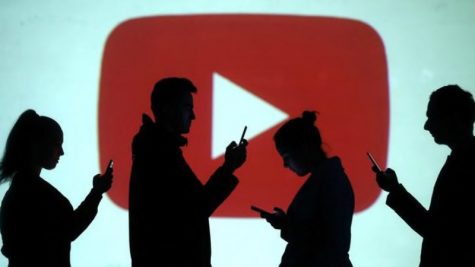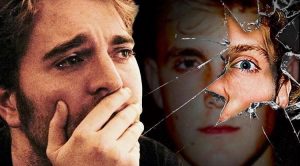Lose the TV, YouTube Is Replacing It
Is YouTube the New Disney Channel? Not Clickbait!
May 16, 2019
Imagine this: it’s 2010 and you’ve just gotten home from school. You flip on the television, sit down on the couch with a few snacks (Gushers, anyone?) and tune into the newest Wizards of Waverly Place episode. Life is simple.
For us older folk in Generation Z (people born from the late ’90s to early 2000s), this was our daily activity after school for most of us. Until now.
With the rise of YouTube and the decrease of television use, kids are now tunning into the latest Emma Chamberlain (the latest and greatest YouTuber right now) episode rather than watching the newest television episode, leaving TV networks like Disney Channel and Nickelodeon in the dust.
Though you may be shedding tears over the sign of the times, this shift is not that bad. The question to be asked is: what caused this tectonic shift in the entertainment industry from kids aged 5-17? What are the key differences between YouTube and your traditional television?
We must turn our attention to the accessibility of the two. While it would be a sight to be seen, you cannot carry your television set around in your back pocket. That means, no tv-on-the-go and less interest peak in return.

YouTube allows its users to use the app whenever, even on-the-go. This allows viewers to always have the opportunity to catch up wth their favorite YouTubers.
However, on the other side of the coin, YouTube allows you the accessibility to watch your favorite YouTuber from the car, in the doctor’s office or walking to school if you have excellent multitasking capabilities (though I would highly advise against that).
YouTube is such a vast platform for entertainment, that viewers can find exact communities for their exact personalities. If your passion is guitar, you can find a plentiful amount of guitar channels suited towards your liking, some channels with comedic bits added into the mix. This is not the case with television networks.
The characters on Disney shows didn’t have super-unique traits that YouTubers have, with bland, cookie-cutter quirks and attributes that could mess with kids further down the road once their true personalities begin to develop. YouTubers are real people with real-world problems, making them more interesting and relatable in return. Niche communities are made within the realm of YouTube, the average consumer having the ability to pick and choose which community they fit into.
One key downside of YouTube, however, is how often videos are put out. With television, you can be ensured that the newest episode of your favorite show will come out on a certain day. With YouTube, this is not the case. YouTubers typically post their videos whenever they see fit, which hurts the interest of their subscribers, who could lose interest over time. If the next video upload is unknown, the YouTuber could lose subscribers or just interest to the channel.
This may seem like a downside, but when a YouTuber does finally post a new video, their subscribers scramble to their computers, excited to see what happens in the latest video: what jokes are made or what ‘tea’ is spilled.
So though your hearts will always stay with the innocence of our younger days and you may rattle your fists toward the new kids on the block and their “strange” habits, don’t act like you haven’t spent many hours on YouTube. It’s an app all of us (for the most part) have fallen victim to, whether we like it or not. On another note, have you seen the latest Bon Appétit video? Amazing!







Christian Rocha ◊ May 30, 2019 at 9:28 am
I do hope that TV is still popular because it is getting annoying that the big corporations are putting down the normal youtubers who actually work hard to put out a single video. Most of my favorite youtubers take a week or two in order to post a video. However companies like BuzzFeed can put out like 5 videos a day with no effort because hundreds of people are working on them. Also most of the videos I watch do get demonetized. My favorite youtuber RacoonEggs is a comedy youtuber that commentates on top of video game gameplay. Every single video he uploads gets demonetized. I understand that what he says is extremely edgy and not for the faint of heart. However 3 or 4 years ago you could say whatever and still earn money. People are going to upload less and less if this continues. Youtube is a horrible platform. The only thing good on it are the people that make videos. I want to watch my favorite people but there is no reason for them to post videos if they cant make any money from it.
Gabe ◊ May 17, 2019 at 10:12 am
I’m pretty sure we just grew out of T.V., and by T.V., I also think you mean cable. In addition, YT has been around for almost a decade and a half, activated on Feb. 14th, 2005. It didn’t become a prospect for technology users until about a year later, when Youtube got it’s first video to a million hits! I’m sure, as many other things, have won over T.V. users, but it’s not a primary factor. Most of my cousins who are around the age of 8-12, still watch TV, and if it’s not T.V., it is Netflix or Hulu. Youtube serves a community niche, with a focus in viewer self-interest and content creator output. Programming is very routine, non-social, and consistent in the KIND of programming it puts out (depending on the channel). Loved the article 🙂
John ◊ May 16, 2019 at 2:33 pm
You tube is bad. They support that dumi james charles.
Ian Pankey ◊ May 16, 2019 at 1:27 pm
YouTube is definitely a gift to this Earth, but let’s just hope they don’t abuse their power over the video-sharing industry. They should be a platform, not a publisher.
Hudson ◊ May 16, 2019 at 1:25 pm
Subscribe to Pewdiepie not Emma Chamberlain
elisey ovchinnikov ◊ May 16, 2019 at 12:49 pm
dats cool I watch fortnite on youtube
Joey ◊ May 16, 2019 at 12:48 pm
Subscribe to Pewdiepie not Emma Chamberlain
Owen ◊ May 16, 2019 at 12:45 pm
Subscribe to Pewdiepie not Emma Chamberlain
Kai ◊ May 16, 2019 at 12:18 pm
This is quite clickbait. As a content creator on multiple platforms (Twitch Zestoy1), most videos become demonetized due to negative comments, or even the contents in the video. And nowadays everything is either on the James Charles controversy or something else, adding on the the plethora of *not clickbait* or the same video over and over again. The internet is slowly dying without things like TV where people can’t plastering their opinions all over the place and give people the wrong impression and send comments and even death threats.
Darrius Rahmanian ◊ May 16, 2019 at 11:57 am
Top 10 Youtubers that arent corporate shills
1.Pewdiepie
2. Mandalore Gaming/SsethTzeenatch
3.Jschlatt
4. Raycevick
5.Gman lives
6.Pyrocynical
7.HistoryBuffs
8.Isorrowproductions
9.Granday
10. Internet Historian
Let’s be honest if you watch makeup YTs or any hype east CRINGE you are adding to the corporatization of YT.